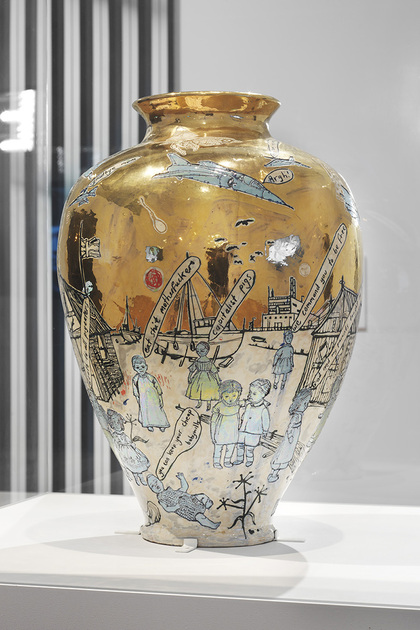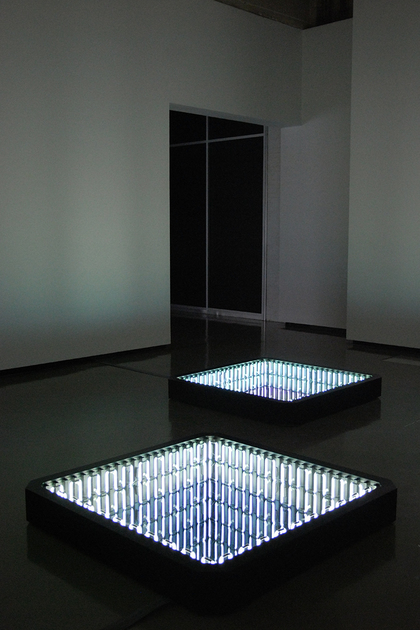-
From Current Issue
-
- Editor’s Letter Fire in the Heart
- Reviews I Gusti Ayu Kadek Murniasih
- Reviews 11th Seoul Mediacity Biennale: “One Escape at a Time”
- Dispatch Networked China
- One on One Monira Al Qadiri on Yukio Mishima
- Essays The rise of independent art spaces in pandemic-era Shanghai
- Features Tuan Andrew Nguyen
- Table of Contents
- Web Exclusives
- Archive
- Subscribe

R
E
V N
E
X
T
Exhibition view of “Age of Terror: Art Since 9/11” at the Imperial War Museum, London, 2017–18, with (left) AI WEIWEI‘s Surveillance Camera with Plinth (2015) and (right) JITISH KALLAT’s Circadian Rhyme 1 (2012–13). Courtesy the Imperial War Museum.
On September 11, 2001, 2,996 human lives were taken when four hijacked planes were steered into targets in New York, Pennsylvania and Virginia. In the period since—presumably the “Age of Terror” referred to in the title of one of the Imperial War Museum’s current exhibitions—roughly half a million people have died as a consequence of the American-led invasions of Afghanistan and Iraq that were rationalized in the wake of the 9/11 attacks, and millions more have died or lost their homes in the ensuing instability that has rocked much of the Middle East.
Given that the greatest legal, political and historical minds still struggle to understand the true impact of these events with any analytic confidence, a meaningful exhibition of post-9/11 art must surely be confined to emotional and personal responses, but not all such responses engage thoughtfully with the subject at hand, and certainly not all should have been displayed in the Imperial War Museum’s show.
The most egregious inclusion was Grayson Perry’s Dolls at Dungeness September 11th 2001 (2001), a work of crass, exploitative narcissism for which—just after hearing of the attacks—the British artist expediently painted some planes and speech bubbles with slogans such as “go on kill yourself for a virgin fuck” onto a glazed ceramic pot he had already been preparing to depict a nuclear power station in Dungeness. Similar lazy opportunism was displayed with equal prominence elsewhere, as in Jake and Dinos Chapman’s Nein! Eleven (2013), whose twin mounds of dismembered Nazi soldiers rendered in plastic has as much moral and political insight as there is cleverness and taste in the artists’ feeble attempt at wordplay.
In a section named “State Control,” apparently intended to explore the consequences of the 9/11 attacks on civil liberties, the curatorial laxity continued with the inclusion of Ai Weiwei’s Surveillance Camera with Plinth (2015). Ai has become famous in part for his work around surveillance, but this artwork is constructed from marble sourced from an imperial Chinese quarry, and is implicitly a comment on his experience of harassment and incarceration by the security apparatus of the Chinese Community Party. While the cultures of surveillance that found justification in countries like the United States and the United Kingdom following the 9/11 attacks may have influenced the adoption of similar strategies in China—the Chinese Communist Party has installed over 20 million security cameras on the country’s streets—Ai’s sculpture is shallow symbolism rather than nuanced analysis or observation.
The exhibition’s more effective works represented engagements with experiences to which the 9/11 attacks and their legacy were actually relevant. Notable among these was Iván Navarro’s The Twin Towers (2011), an installation of two light boxes and mirrors that create the illusion of architectural structures receding endlessly downward into a deep darkness, and—with subtle empathy—invoke the horror of the decision faced by those who threw themselves from the burning buildings on the day of the attacks.
Where the experiences of the quiet majority outside of the United States whose lives have been affected as a consequence of the 9/11 attacks were called upon, it was most significantly with respect to threatened or subverted domesticity. Mona Hatoum’s Natura Morta (Bow-Fronted Cabinet) (2012) consists of a glass-fronted wooden cabinet containing colorful objects that, at closer inspection, are not crockery but mirrored-glass models of grenades and other weapons, injecting instability and violence into items that would usually signify a functioning and happy home. Furthering this concern with domesticity, the majority of work by non-Western artists was found in a final section entitled “Home,” which was separate from the rest of the exhibition. Lida Abdul’s video installation, White House (2005), depicting the artist as she whitewashes the ruins of a former presidential complex near Kabul, powerfully intimates in its imagery and ironic title the difference in destruction suffered in the United States and the first country that was invaded following 9/11. For Homesick (2014), a two-channel installation by Hrair Sarkissian, the artist created a scale model of the Damascus apartment building in which he grew up—and where some members of his family still live—showing it disintegrating in stop-motion while, sweating and grunting on a second channel, he swings a sledgehammer whose blows fall off-screen.
HRAIR SARKISSIAN, still from Homesick, 2014, two-channel video: 11 min 7 sec. Courtesy the artist and Kalfayan Galleries, Athens/Thessaloniki.
When there are so many artists from around the world who have direct experiences of the 9/11 attacks and their aftermath, or have shown a capacity to thoughtfully engage with the human consequences of these events, it was disappointing to see them overshadowed in the Imperial War Museum’s presentation by superficial contributions from well-known artists. An exhibition that aims to address what it means to live in an “Age of Terror”—if indeed we do—must question whether such an époque might arrive at different rates in different states. Unfortunately, this one lacked any such subtlety.
“Age of Terror: Art Since 9/11” is on view at the Imperial War Museum, London, until May 28, 2018.
To read more of ArtAsiaPacific’s articles, visit our Digital Library.






